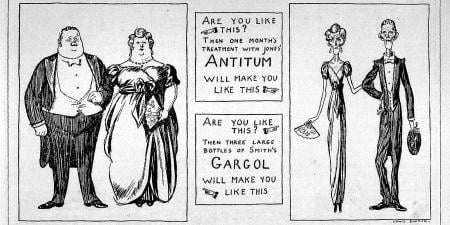Abstract
Diagnostic utility of weight and body mass index (BMI) is widely overestimated. Although both are clinically relevant, their use as universal measures of health and wellness can result in missed or incomplete diagnoses, which are neglected sources of iatrogenic harm. This article problematizes overreliance on weight and BMI in assessing disordered eating behaviors and suggests how physicians can prevent harmful delays in indicated interventions. This article also canvasses misconceptions about the prevalence and severity of eating disorders in people with higher BMIs and encourages holistic approaches to caring for patients with obesity.
Eating Disorders in Patients With High BMI
Eating disorders remain a complex and serious category of diseases, with a wide variety of symptoms that affect both men and women across the United States. It is estimated that 6.37% of Americans alive in 2018 to 2019 will develop an eating disorder in their lifetime, and $64.7 billion is spent each year on treatment for the associated physical and mental repercussions.1 Often, the image brought to mind when one hears the term eating disorder is that of the traditionally portrayed young and markedly thin White woman.2 However, this image does not align with the reality that though some people with eating disorders do fit that mold, eating disorders are not limited to people of a particular gender or size and include those defined clinically as overweight (BMI of 25 to 29.5) or obese (BMI ≥ 30).3
Often, people with overweight or obesity are stigmatized as lazy, noncompliant, or lacking the self-control to follow a healthy lifestyle.4 Current estimates are that 19% to 42% of adults with obesity experience some form of discrimination because of their weight, with higher rates of weight bias among women and people with higher BMIs.5 Few clinicians are truly immune to the social bias against those perceived to have excess weight.4 A recent survey of 13 996 adults in the United States, Canada, Australia, and 3 European countries found that 63% to 74% of patients who had experienced weight stigma reported experiencing weight bias from doctors.6 A second survey of 4732 first-year medical students found that 74% of respondents exhibited implicit weight bias and 67% exhibited explicit bias.7 This bias becomes a problematic barrier to care when eating disorders present in patients from traditionally overweight or obese populations. In a cross-sectional study of young adults 18 to 24 years of age, a higher rate of disordered eating behaviors was found in those who were overweight or obese than in those who were underweight or of normal weight (29.3% of women vs 15.8% of women, respectively, and 15.4% of men vs 7.5% of men, respectively).8 However, those same individuals were half as likely to receive a clinical diagnosis of an eating disorder from a health care practitioner as those who were of normal weight or underweight(2.6% of women vs 4.9% of women, respectively, and 0.3% of men vs 0.6% of men, respectively).8
Thus, when patients from these populations are perceived to be losing weight—even rapidly—physicians may be less inclined to ensure that they are partaking in healthy weight loss and to rule out disordered eating behaviors. One study found that eating disorder diagnoses are delayed by an average of 9 months among patients who were once overweight or obese compared with patients who were never overweight.9,10 Although weight can be an important clinical indicator in certain scenarios, this paper will make the argument that physicians should not exclude diagnoses of eating disorders in patients with higher BMIs in order to prevent harmful delays in treatment. As these disorders significantly affect both men and women, it is important to consider influences on each population.
Men
A survey conducted from 2001 to 2003 estimated that roughly a third of anorexia and bulimia cases are males.11 While there has been substantial research on the effects of weight bias on women,12,13,14 there is less data on the effects of weight bias on men. For example, a 2006 study on weight bias comprised a sample of 2449 women—and a matched sample of 111 men and 111 women.15 One study found that approximately 40% of men had experienced some form of weight bias in a health care setting,16 with the most common form being verbal mistreatment.16 Such stigmatization increases risk of depression and reduced self-esteem.17 In addition, physicians may incorrectly attribute health issues and concerns to weight and BMI and recommend lifestyle changes rather than treatment.17 This finding is consistent with a frequently endorsed stereotype that patients with overweight are usually undisciplined and therefore unreliable narrators of their own health history.17
Current estimates are that 19% to 42% of adults with obesity experience some form of discrimination because of their weight.
Although male patients with eating disorders tend to exhibit characteristics similar to female patients, they do have some key differences. In comparison to women, men with binge-eating disorders are more likely to resort to substance abuse, and men are more likely to have muscle dysmorphia (preoccupation with muscle mass).18 They are also less likely than women to engage in vomiting or laxative abuse and are more likely instead to exercise excessively to compensate for caloric intake.18 Moreover, the average desired body weight (relative to ideal healthy weight) of men with bulimia was higher than for most women with bulimia.19 Finally, one study showed that, while the age of onset for eating disorders tended to be the same for males and females, the mean time before treatment was shorter for males (approximately 2.1 years) than for females with anorexia.19 Considering that recovery from anorexia is poor if left untreated for more than 3 years,20 this delay could significantly worsen patient outcomes. Thus, physicians dismissing concerns of disordered eating due to weight, BMI, or gender can lead to significant delays in treatment and a subsequent decline in the overall standard of care for these populations.
Women
As previously mentioned, anorexia nervosa is 2 times more prevalent among women than men,11 and binge-eating disorders are twice as prevalent among women.21 One study of women with anorexia nervosa found that atypical patients (those with average BMI of 25.2 at the heaviest) “scored significantly higher in a questionnaire that assessed eating disorder psychopathology, which addressed issues such as avoidance of food and eating, preoccupation with calories and eating in secret, feelings of fatness and discomfort seeing one’s body, dissatisfaction with weight and reaction to being weighed.”22 Hence, one of the study authors concluded that “atypical anorexia nervosa is a real illness.”22 From an ethical standpoint, clinicians should remain aware of the substantial iatrogenic harm that can be incurred if they do not consider eating disorders in those with higher BMIs. Additionally, patients in the atypical group “were just as likely as their underweight counterparts to stop menstruating,” and “both typical and atypical patients were susceptible to electrolyte imbalances.”22 This finding suggests that patients with higher BMIs affected by eating disorders often have similar severity of symptoms as those with lower BMIs, and thus early diagnosis and treatment would be of similar clinical benefit in both groups.
Conclusion
Patients with higher and lower BMIs are equally susceptible to disordered eating. The large, community-based Project EAT study, which collected data from 1998 to 1999 and from 2003 to 2004, estimated that 40% of adolescent girls and 20% of adolescent boys in its sample of 2516 adolescents who were overweight or obese engaged in disordered eating behaviors,23 and these prevalences remained stable at a 5-year follow-up in young adulthood.24 Despite this finding and the fact that patients with obesity have a 2.45 times greater chance of engaging in disordered eating behaviors as patients of normal weight, such patients receive a clinical diagnosis of an eating disorder half as frequently as patients with normal weight or underweight.8 Considering that patients with higher BMIs present with disease courses for eating disorders comparable with those of lower BMIs,22 the argument can be made that it is equally critical to catch signs of disordered eating early in these patients so as to initiate intervention and prevent disease progression. While weight and BMI can be useful clinical indicators in many scenarios, it is evident that they are not reliable clinical indicators of the presence of eating disorders, and they should not be used as a sole basis to eliminate eating disorders for differential diagnosis. It is neither ethical nor evidence based therefore to disregard disordered eating behaviors in patients with higher BMIs.
In conclusion, to avoid missing key eating disorders in those with overweight or obesity due to weight bias—and thereby delay treatment—physicians and other medical professionals should regard potential disordered eating behaviors with the same index of suspicion in all patients, regardless of BMI or weight, and adopt a more holistic approach to their management of perceived obesity.
References
-
Austin SB, Hutcheson R, Kandel JS, et al. Social and Economic Cost of Eating Disorders in the United States of America: Report for the Strategic Training Initiative for the Prevention of Eating Disorders and the Academy for Eating Disorders. Deloitte Access Economics; 2020. Accessed November 9, 2022. https://cdn1.sph.harvard.edu/wp-content/uploads/sites/1267/2020/07/Social-Economic-Cost-of-Eating-Disorders-in-US.pdf
-
Riobueno-Naylor A. “Not Just a White Woman’s Disease”: Radicalizing Eating Disorder Knowledge. Bachelor’s thesis. Wellesley College; 2018. Accessed May 11, 2023. https://repository.wellesley.edu/object/ir836
-
Defining adult overweight & obesity. Centers for Disease Control and Prevention. Reviewed June 3, 2022. Accessed September 6, 2022. https://www.cdc.gov/obesity/basics/adult-defining.html
-
Stanford FC. Shame on us for shaming people with excess weight. Association of American Medical Colleges. March 29, 2022. Accessed June 4, 2022. https://www.aamc.org/news-insights/shame-us-shaming-people-excess-weight
- Rubino F, Puhl RM, Cummings DE, et al. Joint international consensus statement for ending stigma of obesity. Nat Med. 2020;26(4):485-497.
-
Puhl RM, Lessard LM, Himmelstein MS, Foster GD. The roles of experienced and internalized weight stigma in healthcare experiences: perspectives of adults engaged in weight management across six countries. PLoS One. 2021;16(6):e0251566.
- Phelan SM, Dovidio JF, Puhl RM, et al. Implicit and explicit weight bias in a national sample of 4,732 medical students: the medical student CHANGES study. Obesity (Silver Spring). 2014;22(4):1201-1208.
- Nagata JM, Garber AK, Tabler JL, et al. Prevalence and correlates of disordered eating behaviors among young adults with overweight or obesity. J Gen Intern Med. 2018;33(8):1337-1343.
- Lebow J, Sim LA, Kransdorf LN. Prevalence of a history of overweight and obesity in adolescents with restrictive eating disorders. J Adolesc Health. 2015;56(1):19-24.
-
Miller A. Losing weight, but not healthy. Monitor on Psychology. 2014;45(11):54. Accessed June 4, 2022. https://www.apa.org/monitor/2014/12/losing-weight
- Hudson JI, Hiripi E, Pope HG Jr, Kessler RC. The prevalence and correlates of eating disorders in the National Comorbidity Survey Replication. Biol Psychiatry. 2007;61(3):348-358.
- Major B, Eliezer D, Rieck H. The psychological weight of weight stigma. Soc Psychol Pers Sci. 2012;3(6):651-658.
- Hunger JM, Tomiyama AJ. Weight labeling and obesity: a 10-year longitudinal study of girls aged 10-19. JAMA Pediatr. 2014;168(6):579-580.
- Puhl RM, Himmelstein MS, Gorin AA, Suh YJ. Missing the target: including perspectives of women with overweight and obesity to inform stigma-reduction strategies. Obes Sci Pract. 2017;3(1):25-35.
- Puhl RM, Brownell KD. Confronting and coping with weight stigma: an investigation of overweight and obese adults. Obesity (Silver Spring). 2006;14(10):1802-1815.
-
Himmelstein MS, Puhl RM, Quinn DM. Weight stigma in men: what, when, and by whom? Obesity (Silver Spring). 2018;26(6):968-976.
- Phelan SM, Burgess DJ, Yeazel MW, Hellerstedt WL, Griffin JM, van Ryn M. Impact of weight bias and stigma on quality of care and outcomes for patients with obesity. Obes Rev. 2015;16(4):319-326.
- Strother E, Lemberg R, Stanford SC, Turberville D. Eating disorders in men: underdiagnosed, undertreated, and misunderstood. Eat Disord. 2012;20(5):346-355.
- Carlat DJ, Camargo CA, Herzog DB. Eating disorders in males: a report on 135 patients. Am J Psychiatry. 1997;154(8):1127-1132.
- Treasure J, Russell G. The case for early intervention in anorexia nervosa: theoretical exploration of maintaining factors. Br J Psychiatry. 2011;199(1):5-7.
-
Eating disorders. National Institute of Mental Health. Accessed June 4, 2022. https://www.nimh.nih.gov/health/statistics/eating-disorders#:~:text=The%20lifetime%20prevalence%20of%20eating,nervosa%2C%20and%20binge%20eating%20disorder
-
Leigh S. Anorexia comes in all sizes, including plus size. University of California San Francisco. November 6, 2019. Accessed November 22, 2022. https://www.ucsf.edu/news/2019/11/415871/anorexia-nervosa-comes-all-sizes-including-plus-size
- Neumark-Sztainer DR, Wall MM, Haines JI, Story MT, Sherwood NE, van den Berg PA. Shared risk and protective factors for overweight and disordered eating in adolescents. Am J Prev Med. 2007;33(5):359-369.
- Loth K, Wall M, Larson N, Neumark-Sztainer D. Disordered eating and psychological well-being in overweight and nonoverweight adolescents: secular trends from 1999 to 2010. Int J Eat Disord. 2015;48(3):323-327.



